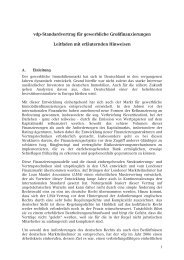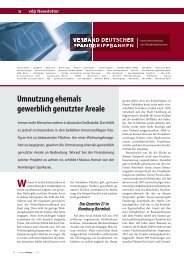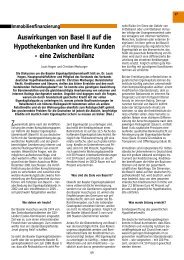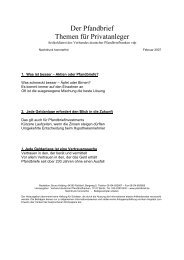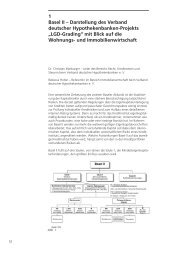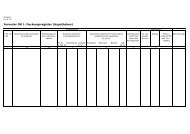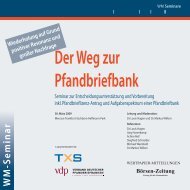The Pfandbrief 2011 | 2012
The Pfandbrief 2011 | 2012
The Pfandbrief 2011 | 2012
Create successful ePaper yourself
Turn your PDF publications into a flip-book with our unique Google optimized e-Paper software.
BW: <strong>The</strong> German mortgage lending value concept is not sufficiently appreciated by the rating<br />
agencies or by many investors, even though additional overcollateralization is implicitly furnished<br />
by applying the mortgage lending value. In dialog with investors, particularly outside<br />
Germany, we spend much of our time explaining the mortgage lending value – as no doubt<br />
other issuers do. We feel very comfortable with the mortgage lending value of 60%, which has<br />
been in place for many years now.<br />
8.<br />
Information and transparency are demands that investors have put forward in recent<br />
months. Is the information required under section 28 of the <strong>Pfandbrief</strong> Act sufficient<br />
as a means of analyzing the strengths and weaknesses of the cover pool of a <strong>Pfandbrief</strong>?<br />
What is your view on requirements drawn up in spring up by the Covered<br />
Bond Investor Council (CBIC)? Are they realistic?<br />
HB: In terms of providing information, German issuers lead the way in Europe because of the<br />
reporting requirements legally stipulated in section 28. Generally speaking, extensive transparency<br />
requirements such as those called for by the CBIC, for instance, are to be welcomed.<br />
German issuers will discuss intensively about the areas in which more high-quality information<br />
can meaningfully be offered to investors. This might be done by individual banks furnishing<br />
voluntary information, by supplementing the reports required under section 28 with a voluntary<br />
part, or by extending the statutory transparency requirements.<br />
61<br />
RG: A high degree of transparency and the regular provision of information are, generally<br />
speaking, useful. However, it should be remembered that the banks’ business models are not<br />
homogeneous, thus making it difficult to compare in a consistent manner issuers and their<br />
cover pools with the help of additional data – particularly as cover pools are quite static when<br />
viewed over the short term, so that significant changes to the collateral are usually not discernible.<br />
From speaking with investors, we see that they very rarely ask questions concerning<br />
the cover pools that go beyond the data disclosed under section 28 of the <strong>Pfandbrief</strong> Act.<br />
9.<br />
When analyzing the data required under section 28, investors quickly find that there<br />
are limits to the comparability of the information furnished. <strong>The</strong> legal provisions<br />
offer a good guideline for uniform disclosure; however, there is a clear need for harmonization,<br />
for example with regard to reporting substitute cover. Is uniform presentation<br />
realistic? What additional information should be published on a selective<br />
basis?<br />
BW: In my opinion, the statutory requirements pursuant to section 28 of the <strong>Pfandbrief</strong> Act still<br />
constitute the benchmark in Europe in terms of providing cover pool data. Where else do you<br />
find legal provisions which stipulate that detailed information on the structure of cover pools<br />
must be provided at regular intervals? What is more, the vdp has, with its transparency initiative,<br />
committed to a broad-based common understanding of and uniform definitions for cover<br />
pool reports. To heighten the comparability of cover pool data, therefore, one should instead<br />
consider information which exceeds the scope of the current requirements under section 28.




